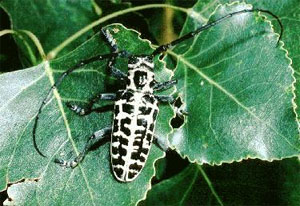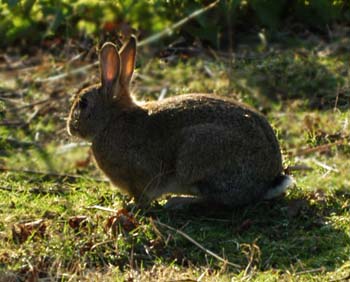Interactions
Populus deltoides has relationships with a wide array of other organisms. A large number of these relationship are parasitic, causing damage to the tree. At least 10 insect species and 12 diseases are the cause of significant damage to the eastern cottonwood.
 While
observing the eastern cottonwood tree, one might discover a relatively large black
and white beetle. This insect is called the cottonwood borer (Plectrodera
scalator). It belongs to the long-horned beetle family, the
Cerambycidae. Impressively, it is the largest member of that family
that is found in the Great Plains and one of the largest beetles occurring
in North America! (40 mm long and 12 mm wide) These beetles are
dependent on the cottonwood throughout their life, from larvae to adulthood.
They eat the leaf stems and new twigs of the tree during the summer.
Following mating, the females will gnaw little holes toward the bottom of
the tree and lay her eggs there. To watch a video of a female beetle
in the process of egg-laying or to just read more about the cottonwood borer
click HERE. The
larvae burrow in the tree and feed on its roots. It takes two years to
complete their life cycle, and once they have achieved metamorphosis, the
new adults gnaw their way out and through the ground. Due to the harm
the cottonwood borers inflict, many small and closely-separated trees will
simply break off from the damage.
While
observing the eastern cottonwood tree, one might discover a relatively large black
and white beetle. This insect is called the cottonwood borer (Plectrodera
scalator). It belongs to the long-horned beetle family, the
Cerambycidae. Impressively, it is the largest member of that family
that is found in the Great Plains and one of the largest beetles occurring
in North America! (40 mm long and 12 mm wide) These beetles are
dependent on the cottonwood throughout their life, from larvae to adulthood.
They eat the leaf stems and new twigs of the tree during the summer.
Following mating, the females will gnaw little holes toward the bottom of
the tree and lay her eggs there. To watch a video of a female beetle
in the process of egg-laying or to just read more about the cottonwood borer
click HERE. The
larvae burrow in the tree and feed on its roots. It takes two years to
complete their life cycle, and once they have achieved metamorphosis, the
new adults gnaw their way out and through the ground. Due to the harm
the cottonwood borers inflict, many small and closely-separated trees will
simply break off from the damage.
As previously mentioned, a number of disease organisms prey upon the eastern cottonwood tree. A list of these parasites include: Septoria musiva, Cytospora chrysosperma, Fusarium solani, Phomopsis macrospora, and Botryodiplodia theobromae. All of those organisms cause cankers on the tree. Melampsora medusae is the cause of leaf rust on the trees which can lead to premature defoliation and a decrease in the growth rate.
Animals such as rabbits and deer occasionally peruse the seedlings and young cottonwood trees, but a considerable area of the trees are able to recover fully from any damage. Beavers also use the young trees for either the building of dams of for food. Unfortunately, the flooding caused by these dam constructions may result in the drowning of cottonwood trees. To be directed to another student's webpage and read more about the fascinating lifestyles of beavers click HERE.
To learn more about other trees found in the La Crosse area, you may choose and click from one of these websites made by other students: Silver Maple, Chestnut, Blue Spruce, Pinus strobus, and Norway Spruce
Back to HOME page

